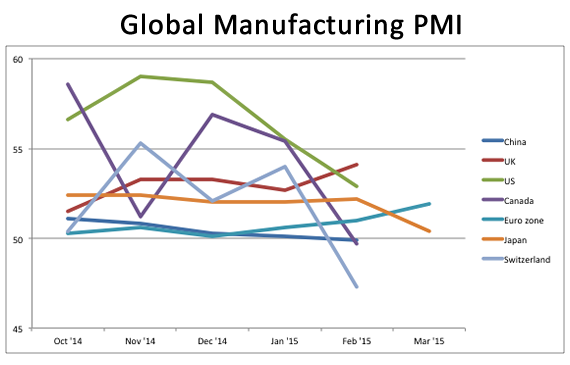Now that most major economies have released their manufacturing PMI readings, let’s take a look at whether trends are improving or not and what this could mean for their respective currency’s forex price action.
But first, for the newbies just tuning in, here’s a crash course on what the PMI or purchasing managers index is all about and why it matters. Simply put, the PMI is a gauge of business conditions in an industry, be it in manufacturing or services or construction. This is based on a survey conducted among purchasing managers, asking them to rate the level of employment, new orders, inventory, deliveries and other business-related indicators during the period.
A PMI reading above 50.0 indicates industry expansion and optimism among businessmen, which is generally reflected in improving economic data later on. Conversely, a PMI reading below 50.0 indicates industry contraction and pessimism among purchasing managers, which usually translates to weaker economic figures down the line.
Now here’s how the manufacturing PMI readings have turned out for most major economies for the past months:

Woah, that’s a lot of colorful lines right there! Lemme break it down for y’all.
First up, let’s focus on the lines that are moving higher, as these show that the manufacturing industries in those countries are seeing a faster pace of expansion. If my eyes ain’t deceiving me, I’m seeing improvements in the U.K. (red line) and in the euro zone (turquoise line). Ha, it looks like ECB Governor Draghi was on to something when he claimed that a “sustained recovery” is taking hold in the region!
And now for the rest of the major economies which seem to be undergoing a downturn in manufacturing… Switzerland (light blue line) and Canada (purple line) appear to have suffered a sharp deterioration in manufacturing conditions, as their readings have also dipped below the 50.0 mark in February after previously reflecting industry expansion. Growth in China’s (blue line) and Japan’s (orange line) manufacturing sector has gradually slowed down while the U.S. (green line) has taken it down a few notches as well.
With the manufacturing PMI typically considered a leading indicator of economic conditions such as hiring and spending, forex price action of these currencies might be in for the same trends in the next few weeks or months. Do you think this could be the case? Or will other indicators have a bigger say in market movements?
Recommended Content
Editors’ Picks
EUR/USD holds below 1.0750 ahead of key US data

EUR/USD trades in a tight range below 1.0750 in the European session on Friday. The US Dollar struggles to gather strength ahead of key PCE Price Index data, the Fed's preferred gauge of inflation, and helps the pair hold its ground.
USD/JPY stays firm above 156.00 after BoJ Governor Ueda's comments

USD/JPY stays firm above 156.00 after surging above this level on the Bank of Japan's decision to leave the policy settings unchanged. BoJ Governor said weak Yen was not impacting prices but added that they will watch FX developments closely.
Gold price oscillates in a range as the focus remains glued to the US PCE Price Index

Gold price struggles to attract any meaningful buyers amid the emergence of fresh USD buying. Bets that the Fed will keep rates higher for longer amid sticky inflation help revive the USD demand.
Bitcoin Weekly Forecast: BTC’s next breakout could propel it to $80,000 Premium

Bitcoin’s recent price consolidation could be nearing its end as technical indicators and on-chain metrics suggest a potential upward breakout. However, this move would not be straightforward and could punish impatient investors.
US core PCE inflation set to signal firm price pressures as markets delay Federal Reserve rate cut bets

The core PCE Price Index, which excludes volatile food and energy prices, is seen as the more influential measure of inflation in terms of Fed positioning. The index is forecast to rise 0.3% on a monthly basis in March, matching February’s increase.